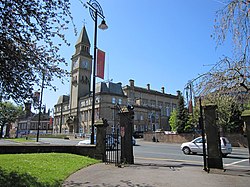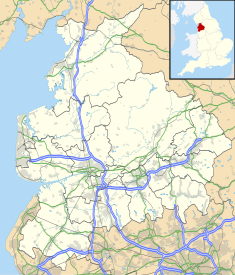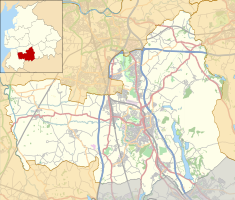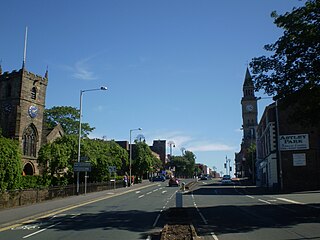
Chorley is a town and the administrative centre of the wider Borough of Chorley in Lancashire, England, 8 miles (13 km) north of Wigan, 11 miles (18 km) south west of Blackburn, 11 miles (18 km) north west of Bolton, 12 miles (19 km) south of Preston and 20 miles (32 km) north west of Manchester. The town's wealth came principally from the cotton industry.

The Borough of Chorley is a local government district with borough status in Lancashire, England. It covers the towns Adlington and Chorley. The borough also extends to several villages and hamlets including Buckshaw Village, Croston, Eccleston, Euxton and Whittle-le-Woods.
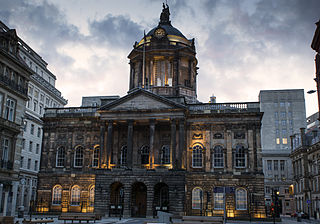
Liverpool Town Hall stands in High Street at its junction with Dale Street, Castle Street, and Water Street in Liverpool, Merseyside, England. It is recorded in the National Heritage List for England as a designated Grade I listed building, and described in the list as "one of the finest surviving 18th-century town halls". The authors of the Buildings of England series refer to its "magnificent scale", and consider it to be "probably the grandest ...suite of civic rooms in the country", and "an outstanding and complete example of late Georgian decoration".
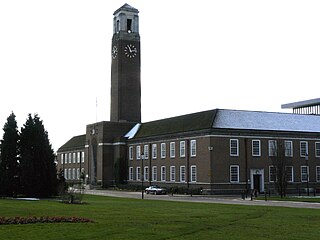
Swinton and Pendlebury was a local government district of the administrative county of Lancashire, England. It was created in 1894 as an urban district and enlarged in 1934, gaining the status of a municipal borough.

The Harris Museum is a Grade I-listed building in Preston, Lancashire, England. Founded by Edmund Harris in 1877, it is a local history and fine art museum.

Halifax Town Hall is a grade II* listed, 19th century town hall in the town of Halifax, West Yorkshire, England. It is notable for its design and interiors by Charles Barry and his son, Edward Middleton Barry, and for its sculptures by John Thomas. The town hall is also the headquarters of Calderdale Metropolitan Borough Council.

Salford Civic Centre, formerly Swinton and Pendlebury Town Hall, is a municipal building at Chorley Road, in Swinton, Greater Manchester, England. It is the administrative headquarters of Salford City Council.

Leigh Town Hall is a municipal building in Leigh, Greater Manchester, England. It stands in Civic Square at the junction with Market Street, facing Leigh parish church. It was built in 1907 and granted grade II listed building status in 1987.
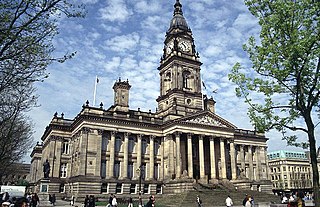
Bolton Town Hall in Victoria Square, Bolton, Greater Manchester, England, was built between 1866 and 1873 for the County Borough of Bolton to designs by William Hill of Leeds and George Woodhouse of Bolton. The town hall was extended in the 1930s to the designs of Bradshaw, Gass and Hope and has been designated a Grade II* listed building by English Heritage.

Bury Town Hall is a municipal building in Knowsley Street, Bury, Greater Manchester, England. The town hall, which is the headquarters of Metropolitan Borough of Bury, is a locally listed building.
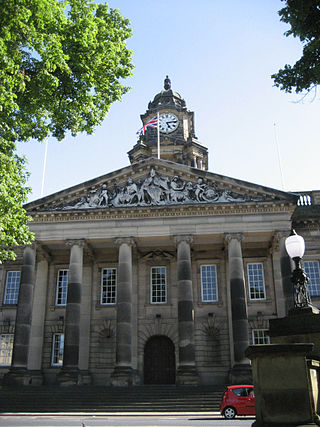
Lancaster Town Hall is a municipal building in Dalton Square, Lancaster, Lancashire, England. It was built in 1909 and is a Grade II* listed building.

The Guildhall is a municipal building in High Street, Newcastle-under-Lyme. It is a Grade II listed building.

The Town Hall, Christchurch is a municipal building in Christchurch, Dorset, England. The building, which incorporates a room known as the mayor's parlour on the first floor, and is a Grade II listed building. It is currently the base of Christchurch Town Council.

Stockton-on-Tees Town Hall is a municipal building in the High Street in Stockton-on-Tees, County Durham, England. The building, which is the meeting place of Stockton-on-Tees Borough Council, is a Grade II* listed building.

Preston Town Hall is a municipal building in Lancaster Road in Preston, Lancashire, England. The town hall, which is the headquarters of Preston City Council, is a Grade II listed building.

Darwen Town Hall is a municipal building in Croft Street, Darwen, Lancashire, England. It is the meeting place of Darwen Town Council.
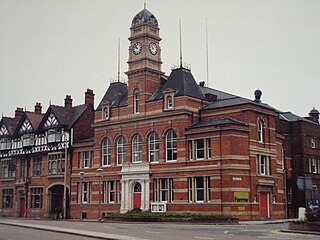
Eccles Town Hall is a municipal building in Church Street, Eccles, Greater Manchester, England. The town hall was the headquarters of Eccles Borough Council until the council was abolished in 1974.

Westhoughton Town Hall is a municipal building in Market Street, Westhoughton, Greater Manchester, England. The town hall is the meeting place of Westhoughton Town Council.

Dudley Council House is a municipal building in Priory Road, Dudley, West Midlands, England. The Council House, which is the meeting place of Dudley Metropolitan Borough Council is a Grade II listed building.

Garstang Town Hall is a municipal building in the High Street in Garstang, Lancashire, England. The structure, which currently accommodates two shops and a Royal British Legion Club, is a Grade II listed building.
